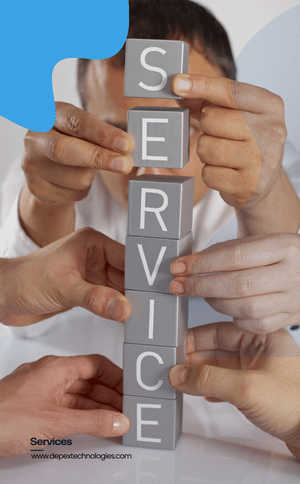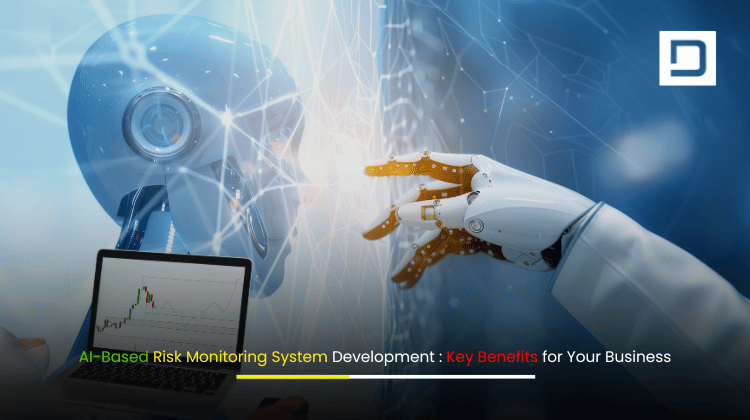AI-Based Risk Monitoring System Development: Key Benefits for Your Business
In today’s fast-evolving business landscape, risk is everywhere. From financial fraud and cybersecurity threats to operational inefficiencies and regulatory compliance, organizations are under constant pressure to detect, assess, and mitigate risks in real-time. AI-Based Risk Monitoring System Development has emerged as a game-changing solution, empowering businesses to stay ahead of threats, make informed decisions, and ensure long-term sustainability. By leveraging artificial intelligence, machine learning, and data analytics, companies across industries are transforming their risk management strategies—unlocking new levels of agility, security, and value.
In this detailed guide, we’ll explore the fundamentals of AI-Based Risk Monitoring System Development, review its core benefits, deep-dive into industry-specific advantages, explain how these systems work, and show you why Depex Technologies is your ideal partner for building a future-ready risk monitoring platform. Whether you’re in finance, healthcare, manufacturing, retail, or any other sector, understanding and implementing AI-based risk monitoring can be a strategic move that defines your business’s success.
How AI-Based Risk Monitoring Works
At the core of AI-Based Risk Monitoring System Development are several key components:
- Data Collection & Integration: The system ingests data from multiple sources—transaction logs, emails, sensors, CRM/ERP platforms, IoT devices, third-party APIs, and more.
- Preprocessing & Cleansing: Raw data is cleansed, normalized, and structured for analysis.
- AI & ML Algorithms: Advanced algorithms analyze the data for anomalies, patterns, correlations, and potential risks. Techniques include supervised and unsupervised learning, clustering, and neural networks.
- Real-Time Monitoring: The system continuously scans data streams, adapting models as new threats emerge.
- Automated Alerts & Reporting: When suspicious activities or risk indicators are detected, automated alerts are triggered for immediate investigation.
- User Dashboards: Stakeholders access intuitive dashboards for risk visualization, deep-dive analytics, and actionable recommendations.
- Continuous Learning: AI models evolve over time, improving accuracy as they are exposed to new data.
The result is a proactive, always-on risk management solution that minimizes human error and maximizes response speed.
Core Benefits of AI-Based Risk Monitoring Systems
Implementing an AI-Based Risk Monitoring System Development strategy delivers transformative benefits, including:
Real-Time Threat Detection
AI systems analyze incoming data in real time, catching threats and anomalies the moment they appear. This immediate awareness is crucial for stopping fraud, cyberattacks, or operational failures before they escalate.
Reduced False Positives
Unlike rule-based systems, AI models continuously learn from historical data, reducing noise and minimizing false alarms. This means teams can focus on real risks rather than wasting time on irrelevant alerts.
Predictive Analytics
AI enables predictive risk modeling, allowing businesses to forecast future threats based on trends, behaviors, and market signals. This forward-looking approach supports smarter decision-making and long-term planning.
Operational Efficiency
Automation eliminates tedious manual reviews, freeing up valuable human resources for higher-level analysis and strategic work. Businesses experience faster response times, lower operational costs, and increased productivity.
Enhanced Compliance
With evolving regulatory requirements, AI-based risk monitoring systems keep organizations ahead of compliance mandates. Automated record-keeping, audit trails, and policy enforcement ensure robust governance.
Customization and Scalability
AI risk monitoring platforms are highly customizable, adapting to unique industry needs and growing with your business. Whether you’re a startup or a large enterprise, these systems scale to match your risk profile.
Continuous Improvement
Machine learning models improve over time as they process more data, delivering higher accuracy, adaptability, and business value year after year.
Industry-Specific Advantages
Every industry faces distinct risks. This section examines how AI-Based Risk Monitoring System Development drives value across key verticals—explaining tailored benefits for each.

Finance & Banking
Key Benefits:
- Fraud Detection & Prevention: AI algorithms monitor transactions in real-time, flagging suspicious activity and reducing losses from fraud, money laundering, and insider trading.
- Credit Risk Assessment: Predictive models analyze borrower behavior, enabling accurate credit scoring and proactive loan management.
- Regulatory Compliance: Automated checks ensure adherence to AML, KYC, and other regulatory frameworks, reducing compliance costs and penalties.
Example: Major banks have reduced fraud losses by up to 50% and compliance review times by 70% using AI-powered systems.
Healthcare
Key Benefits:
- Patient Safety Monitoring: AI tracks anomalies in patient care, medication administration, and clinical workflows, preventing errors and improving outcomes.
- Regulatory & Data Privacy Compliance: Automated audits ensure HIPAA and GDPR compliance, minimizing legal risk.
- Financial Risk Management: Detects fraudulent billing, insurance fraud, and improper claims in real time.
Example: Hospitals leveraging AI-based risk monitoring have seen significant reductions in medical errors and billing fraud.
Manufacturing & Supply Chain
Key Benefits:
- Supply Chain Resilience: AI predicts disruptions (e.g., supplier delays, demand spikes) and recommends actions to mitigate risks.
- Quality Assurance: Monitors sensor and production line data for defects or process deviations, reducing recalls and improving product quality.
- Workplace Safety: Real-time tracking of incidents and environmental factors, ensuring compliance with health and safety regulations.
Example: Leading manufacturers have improved delivery reliability and reduced downtime with predictive risk analytics.
Retail & E-Commerce
Key Benefits:
- Fraudulent Transaction Prevention: Monitors purchases, returns, and customer behaviors to detect scams or policy violations.
- Inventory Risk Management: AI forecasts demand, tracks stock anomalies, and identifies shrinkage or theft.
- Customer Experience Optimization: Identifies risks in the customer journey (e.g., website outages, delivery delays) for proactive resolution.
Example: E-commerce companies have increased profit margins and customer trust by integrating AI-based risk management.
Energy & Utilities
Key Benefits:
- Critical Infrastructure Protection: Monitors SCADA systems, detecting cyber threats or equipment failures before they impact services.
- Operational Risk Analytics: Predicts maintenance needs, reducing outages and costly emergency repairs.
- Regulatory Compliance: Automates documentation and reporting to meet strict environmental and safety standards.
Example: Utility providers have cut downtime and improved grid stability with AI-driven risk detection.
Insurance
Key Benefits:
- Claims Fraud Detection: AI analyzes claims data for inconsistencies, suspicious patterns, or exaggerated losses.
- Risk-Based Pricing: More accurate risk profiles enable fair, customized premiums for policyholders.
- Regulatory Compliance: Ensures alignment with industry mandates through real-time monitoring and documentation.
Example: Insurers have saved millions annually through automated fraud detection and risk scoring.
Government & Public Sector
Key Benefits:
- Public Safety & Fraud Monitoring: AI identifies anomalies in benefits distribution, procurement, and public safety systems.
- Regulatory Enforcement: Automates compliance checks for agencies and contractors.
- Disaster Risk Management: Predictive analytics support crisis response and resource allocation.
Example: Government agencies have improved transparency and citizen trust with real-time, data-driven risk management.
Technology & SaaS
Key Benefits:
- Cybersecurity Threat Detection: Monitors network and application activity, identifying breaches or vulnerabilities before they are exploited.
- Operational Risk Monitoring: Detects outages, API failures, and performance degradation.
- Customer Data Privacy: Ensures compliance with global data protection regulations.
Example: SaaS providers have strengthened platform security and minimized downtime with AI-enabled risk monitoring.
AI-Powered Features that Transform Risk Monitoring
Modern risk monitoring systems go far beyond basic alerts. This section details the advanced AI features that make these solutions powerful and indispensable.
- Anomaly Detection: Machine learning models identify outliers and subtle changes in behavior that signal risk.
- Natural Language Processing (NLP): AI scans emails, chat logs, and documents to flag potential threats or compliance issues.
- Predictive Modeling: Forecasts emerging risks using historical and real-time data.
- Automated Workflow Triggers: Initiates immediate actions—such as locking accounts or escalating incidents—when risks are detected.
- Dynamic Risk Scoring: Continuously updates risk profiles based on the latest data, ensuring accurate prioritization.
- Self-Learning Algorithms: Models evolve and improve, adapting to new risk patterns as they emerge.
- Visual Dashboards & Reporting: Delivers actionable insights with intuitive, interactive visuals for all stakeholders.
- AI-Powered Alerts: Notifies the right people, at the right time, via their preferred channels (email, SMS, app).
These features combine to provide a robust, future-proof risk management platform.

Integrations with CRM, ERP & Other Enterprise Systems
To maximize value, AI-based risk monitoring must integrate seamlessly with your existing business software—CRM, ERP, HRM, and more. This section explains how and why these integrations matter.
AI-Based Risk Monitoring System Development becomes exponentially more powerful when connected to the systems your teams use every day:
- CRM Integration: Syncs customer interactions, flags risky behaviors, and helps sales/service teams act on early warnings.
- ERP Integration: Monitors financial transactions, supply chain events, and vendor activities in real time.
- HRM Integration: Tracks employee activities for compliance, insider threats, or HR policy violations.
- Ticketing/ITSM Integration: Automates the creation and resolution of risk-related support tickets.
By centralizing risk data across platforms, businesses gain a holistic view of vulnerabilities, ensure swift remediation, and maintain business continuity. Custom APIs and middleware can further tailor integrations for industry-specific needs.
Challenges and Best Practices
No transformation is without its challenges. This section addresses common hurdles in AI-Based Risk Monitoring System Development and shares best practices to ensure project success.
Common Challenges:
- Data Quality: Inaccurate or incomplete data can undermine AI effectiveness.
- Change Management: Resistance from teams used to legacy systems.
- Regulatory Complexity: Staying ahead of evolving compliance requirements.
- Cybersecurity: Securing sensitive risk data from attacks.
Best Practices:
- Start Small, Scale Fast: Begin with high-impact use cases, then expand system capabilities.
- Stakeholder Buy-In: Involve risk, IT, and business teams early for smoother adoption.
- Data Governance: Implement strong data quality controls and privacy protocols.
- Continuous Training: Regularly update and retrain AI models as new threats emerge.
- Vendor Selection: Partner with experienced AI solution providers, like Depex Technologies, for robust, future-proof systems.
Future Trends: The Road Ahead for AI in Risk Monitoring
AI in risk management is evolving fast. This section forecasts future trends and what businesses can expect from the next generation of risk monitoring platforms.
- Explainable AI: More transparent AI models help stakeholders understand and trust risk predictions.
- Autonomous Remediation: AI will increasingly take direct action to mitigate threats without human intervention.
- Cross-Industry Data Sharing: Secure sharing of risk data will enable collaborative threat intelligence.
- IoT & Edge Integration: Risk monitoring will extend to billions of connected devices, providing real-time insights from the edge.
- AI-Powered Compliance Automation: Systems will handle regulatory reporting, evidence collection, and audits automatically.
- Human-AI Collaboration: Risk teams will work hand-in-hand with AI, combining intuition with machine precision.
Businesses that adopt these advancements early will be best positioned to thrive in a risk-prone world.
Why Choose Depex Technologies for AI-Based Risk Monitoring System Development
Selecting the right technology partner can make all the difference. Here’s why Depex Technologies is your ideal choice for AI-Based Risk Monitoring System Development.
Depex Technologies stands at the forefront of AI innovation, delivering custom-built risk monitoring systems that empower businesses to mitigate threats and drive growth. Here’s what sets us apart:
- Proven Expertise: Our experienced team brings deep domain knowledge in AI, data science, cybersecurity, and risk management, ensuring that your solution meets industry-specific needs and compliance standards.
- End-to-End Development: From initial consulting and risk assessment to design, development, and deployment, we manage the entire project lifecycle—ensuring seamless integration with your existing systems (CRM, ERP, and more).
- Tailored Solutions: We don’t believe in one-size-fits-all. Our platforms are highly customizable, adapting to your unique business processes, risk profiles, and growth ambitions.
- Cutting-Edge Technology: We leverage the latest AI/ML models, automation, cloud architecture, and advanced analytics to build future-proof systems.
- Scalability & Security: Our solutions scale as you grow and are built with robust security measures to protect your sensitive data.
- Agile Delivery: We use agile methodologies, enabling rapid prototyping, regular feedback, and on-time delivery—so you realize value quickly.
- Dedicated Support: Post-launch, our team remains at your side for training, maintenance, and ongoing optimization.
- Competitive Pricing: Get the highest ROI with flexible engagement models and transparent pricing tailored to your budget.
When you choose Depex Technologies, you get more than a technology vendor—you gain a trusted innovation partner focused on your business success.
Conclusion: Secure Your Business Future with Depex Technologies
Risk is inevitable—but unmanaged risk can be disastrous. With the explosion of data, evolving cyber threats, and stricter regulations, organizations need to move beyond traditional risk management and embrace AI-powered solutions that offer speed, accuracy, and insight.

AI-Based Risk Monitoring System Development is not just a technology upgrade; it’s a strategic investment in your company’s future. By automating threat detection, reducing false positives, enabling predictive analytics, and enhancing compliance, these systems empower your teams to focus on innovation, customer experience, and growth.
Now is the time to take control of your risk landscape. Partner with Depex Technologies to design and deploy an AI-based risk monitoring system tailored to your industry, objectives, and vision. Our expert team will guide you from ideation to implementation, helping you unlock unprecedented resilience, efficiency, and competitive edge.
Don’t wait for the next crisis—be proactive. Contact Depex Technologies today for a free consultation and discover how AI-Based Risk Monitoring System Development can transform your business for the better.






